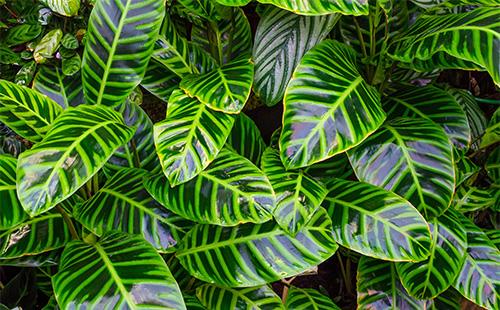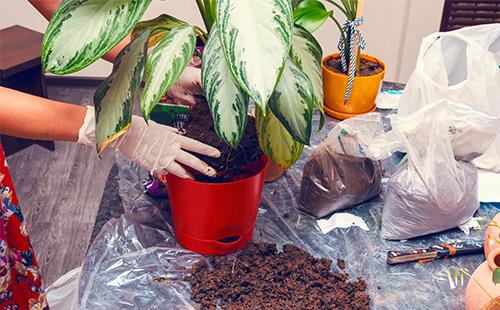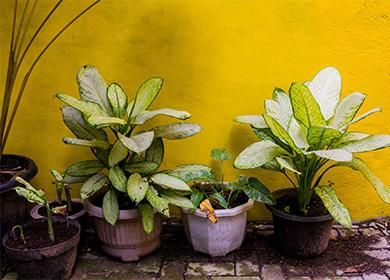The content of the article
Dieffenbachia belongs to the evergreens of the aroid family. Very effective, but difficult to grow flower. Without proper care, it quickly loses its decorative effect. The natural habitat is the tropical climate of South America.
Plant description
Large plants with strong stems. Depending on the variety, the size and color of the leaves vary. There are species with plain and variegated leaves. Some species are scrubbed. Lateral shoots grow both from the base and in the upper part of the stem.
The leaves are large, elongated-oval. On the stem, the leaves are arranged alternately. Dieffenbachia is growing rapidly. In favorable conditions, a new young leaf appears every week. Dimensions vary by grade and care. There are medium and tall varieties. Medium-sized grow up to a meter, tall - up to two.
Popular varieties
In total, there are more than 50 species of Dieffenbachia. Among them there are natural varieties and varieties bred artificially by breeders.
- Dieffenbachia Baragudin. The variety is interesting in unusual coloring. The leaves are dark with single white spots of different shapes. Petioles and main leaf vein white.
- Dieffenbachia Leopold. The leaves are elliptical, wide, dark in color, sitting on a short stalk. Purple stains stand out on pale petioles. The middle veins of the leaves are white.
- Dieffenbachia spotted. The stems are high - up to a meter. The leaves are large, attached to the stem with long stalks. Form - lanceolate or oblong-elongated, pointed at the apex. Light spots stand out clearly against a green background.
- Dieffenbachia Seguin. In appearance it resembles variegated dieffenbachia. The difference is wider leaves, fewer spots, less lateral veins.
- Dieffenbachia is lovely. Unpretentious grade - resistant to shading and dry air. Tall variety - the height of the stem reaches one and a half meters, leaves up to half a meter in length. Leaves are dark with white stripes.
Caring for Dieffenbachia and creating the “right” microclimate
This is a tropical plant, so growing Dieffenbachia at home requires the creation of a favorable microclimate. Without constant care, the plant loses its decorative effect.
- Lighting. For variegated varieties (with variegated leaves) you need an abundance of scattered light. Direct sun exposure is completely ruled out. In low light, the color characteristic of the variety is lost, decorativeness decreases.Varieties with dark monophonic leaves make light partial shade. Allowed their placement in the corner of the room under the condition of full artificial lighting.
- Temperature. Dieffenbachia needs a constant temperature regime. She does not tolerate temperature spikes. In summer, it is maintained at a level of 21 ° C to 25 ° C. In winter, a little lower - from 18˚С to 20˚С.
- Watering. It is recommended to water Dieffenbachia with warm, softened water two days after drying the soil surface. In the warm season, they are watered abundantly, but they are not brought to waterlogging of the soil.
- Humidity. Spraying is good. If the air is dry, dieffenbachia is sprayed daily. Young plants are bathed periodically under a warm shower, adults are wiped with a damp soft cloth.
- Top dressing. In the warm period, top dressing is made three times a month. Use complexes for decorative and deciduous crops, the dosage is halved. A small amount of lime is added periodically. Organic is rarely fed, in moderation - an excess of organic substances leads to a smoothing of the characteristic color.
- Transfer. If the root system ceases to fit in the pot, Dieffenbachia should be transplanted. The optimal period for transplanting is spring. Young plants sometimes have to be replanted twice a year. The root system is better not to disturb. Dieffenbachia is transplanted by transshipment into a new larger pot.
- The soil. Use moisture-permeable and water-permeable soils with low acidity. The soil mixture consists of peat, sand, deciduous land, turf. Universal soils are improved by the addition of sand, perlite, crushed charcoal. An important condition for full development is quality drainage.
- Pruning. Dieffenbachia requires periodic rejuvenation - as the growth grows, the lower part of the stem is exposed. The top is cut to a bare stem, washed from milky juice and rooted.
Propagation Features
It is almost impossible to obtain seeds on your own, therefore, vegetative propagation methods are used mainly. Cuttings are carried out at any time of the year.
Cuttings
Description. For the propagation of dieffenbachia by cuttings, the apical and stem parts are used. It is easiest to root them in an improvised greenhouse with heated bottom.
Action algorithm
- After cutting the tops to rejuvenate dieffenbachia, the stump remaining in the pot continues to be watered.
- With timely watering and top dressing, it will give lateral shoots, which can also be used for rooting.
- Cuttings are rooted in water, sand, sand-peat mixture, sphagnum.
- The main conditions for successful rooting are moderate temperatures of 21-24 ° C, bright diffused light, regular spraying.

Layering
Description. In practice, air layers are rarely used. In this case, you can damage the mother plant and not get the result.
Action algorithm
- Small cuts are made on the stem, wrapped with moist sphagnum and wrapped with opaque polyethylene.
- After the roots appear, the stem along with the film is cut off.
- After trimming, the film is removed, layering together with moss is planted in a light substrate.
Possible difficulties
Since it is not very easy to take care of dieffenbachia in a pot, novice gardeners often encounter difficulties. The most common growing problems are shown in the table.
Table - Difficulties in growing Dieffenbachia
| Growing difficulties | Possible reasons |
|---|---|
| The tips of the leaves are dry | - High or low temperature; - dry air; - drafts; - stagnation of fluid in the root area; - spraying when kept in the sun |
| Leaf color fades | - poor lighting; - an overdose of nitrogen; - lack of phosphorus and potassium |
| Leaves fade and deform | - Alkalization of the substrate |
| Lower leaves wither and dry | - Close pot |
| The stalk loses color and softens. | - decay |
| Leaves curl | - cold; - drafts; - disturbed salt balance of the soil |
| The edges of the leaves turn brown | - Dryness of the substrate; - cold air |
| Dieffenbachia leaves turn yellow | - Content in the open sun; - dry air; - irregular watering; - lack or excess of fertilizers |
All of these problems are addressed by adjusting care and living conditions. When decaying, immediate transplantation with the removal of damaged tissue is recommended. With severe rot of the base of the stem, the top is cut to a healthy tissue and rooted.
Major diseases
Diseases are rare. Healthy plants that receive proper care are resistant to viruses, bacteria and fungi. Violation of the conditions of detention weakens dieffenbachia, increases the likelihood of infection. The main diseases and their manifestations are described in the table.
Table - Dieffenbachia diseases
| Disease name | Signs | Treatment |
|---|---|---|
| Soft rot | - Lack of growth; - pallor of color; - lethargy of leaves; - yellowing of the lower leaves; - cracking of the base of the stem | - Not subject to treatment; - root the top to get a new plant |
| Bacterial spotting | - Yellow spots with a clear border on the edges of the leaves | - Treatment with fungicides "Rovral", "Euparen", "Fundazol" |
| Late blight | - Lethargy and drying of individual leaves; - spread of rot from the bottom of the stem to the top | - Not subject to treatment; - infected dieffenbachia destroyed |
| Anthracnose | - Wet spots on the leaves | - Cut the affected leaves; - reduce air humidity; - treated with fungicides "Fundazol", "Euparen". |
As a preventive measure, dieffenbachia is periodically sprayed with a weak solution of the fungicide Fundazole, the soil is monitored, waterlogging is prevented, and high-quality drainage is provided.

Frequent pests
Almost all pests appear at low humidity. Infection can occur from recently purchased plants, poor-quality soil. Some insects enter the apartment through open windows. The signs of the appearance of the main pests and methods of combating them are given in the table.
Table - Pests of Dieffenbachia
| Insect name | Signs of occurrence | Control measures |
|---|---|---|
| Aphids | - Curl of leaves; - yellowing of the leaves; - sticky, sticky discharge | - Washing leaves with soapy water; - spraying with tobacco dust, preparations "Akarin", "Bison", "Spark" |
| Shields | - Golden brown plaques on the stems; - drops of sticky fluid | - Mechanical cleaning of plants from pests; - rubbing the affected areas with alcohol or kerosene; - spraying with insecticides "Inta-vir", "Actellik" |
| Worms | - Waxy whitish discharge on petioles and leaf veins | - Processing with mineral oil; - insecticide treatment |
| Spider mite | - The appearance of yellowish dots; - the formation of dried, colorless patches; - spider web on the back of the leaves | - Treatment with soapy water; - spraying with insectoacaricides |
| Thrips | - Yellowish-white color of individual sections of leaves; - dark dots; - drying and falling of leaves | - Repeated use of insecticides Fitoverm, Iskra, Tanrek |
Caring for Dieffenbachia is not the easiest, but the effort and time spent are fully paid off by the high decorativeness of the plant. Dieffenbachia is an ideal option for landscaping spacious apartments and office premises.

